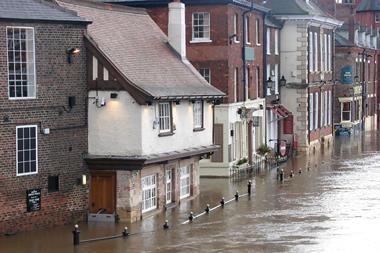Following November’s Cop27 conference, the impact of weather events influenced by climate change has hit home – and brokers are looking outside of traditional covers to help clients
The devastating floods that hit Pakistan in September last year were near the top of delegates’ minds at 2022’s United Nations Climate Change Conference (Cop27) in Egypt, which concluded in November amid widespread acrimony.
This year’s summit was focused on finding ways of mitigating just the kind of loss and damage that left 33 million Pakistani people homeless in 2021.
But climate unpredictability is not just a problem for third world countries like Pakistan – developed nations, like the UK, are also feeling the effects of climate change.
For example, in November 2022, the Office for National Statistics (ONS) reported that the 21st century so far has been warmer overall than any period of equivalent length in the previous three centuries - all seasons are now warmer than at any time since its records began in 1659.
The ONS’ Climate change insights, natural and rural environments, UK: November 2022 bulletin further noted that national weather service The Meteorological Office has estimated that sea levels will rise by approximately 11cm by 2030, 19cm by 2050 and 36cm by 2100.

The Met Office itself has also reported in detail about changes to the UK’s weather and possible links to climate change. Its website stated, for example, that “heavy rainfall is more likely”.
Its Effects of climate change page continued: “Since 1998, the UK has seen six of the 10 wettest years on record. The winter storms in 2015 were at least 40% more likely because of climate change.”
Graham Smart, chief commercial officer at loss adjusting firm McLarens, also believes that flooding is becoming increasingly common worldwide as a result of global warming.
He said: “The global climate is changing dramatically and we see very changeable seasons - flooding is now a common feature in the summer.
“There isn’t the kind of certainty or predictability about such events in the UK that can be seen in other parts of the world. The events that we see in the UK really vary in timing and location.”
Positives of parametric cover
The increasingly volatile nature of the environment is helping to fuel industry interest in parametric insurance.
Unlike traditional indemnity cover, parametric insurance is based on the concept that the customer will receive a payout if a set, predetermined trigger point is reached. In the case of a flood, for example, the policy trigger could be when the water level in a property hits a certain height.
The sum of the claim payout will already have been decided using a predetermined method of calculating losses, rather than being based on an assessment of the actual loss and damage that has occurred.
Adam Rimmer is chief executive of FloodFlash, an MGA which specialises in the provision of parametric insurance for businesses located in flood prone properties in the UK and the USA.
The MGA’s products aim to help to fill a gap in the flood insurance market for commercial properties, which do not benefit from the safety net offered by the government-backed Flood Re reinsurance scheme.
Rimmer first became attracted to parametric insurance when advising his FloodFlash co-founder and chief scientist, Ian Bartholomew, to arrange cover for the New York City Subway after it flooded during Hurricane Sandy in 2012.
The subway eventually turned to a parametric proposition after struggling to secure adequate cover from conventional insurers.
Rimmer explained: “If water levels in Manhattan got to something like Sandy again, then the subway would get paid a whole chunk of money straightaway.”
Rimmer and Bartholomew subsequently saw the potential of offering this concept to small businesses that typically can’t afford to pay huge sums for advice, unlike the New York City Subway.
Read: ‘Only a matter of time’ until parametric insurance becomes the norm
Read: Parametric ‘ugly duckling’ could become sector’s ‘future’
Explore more news analysis here, or read up on products here.
Many of FloodFlash’s typical customers are small or medium-sized businesses that are tied to the location they operate in. The company’s clients are “over-indexed” in manufacturing, while other clientele examples include a single malt whiskey distillery and three professional football clubs.
For low frequency but high severity events, like catastrophic floods, parametric insurance strips out much of the underwriting uncertainty, Rimmer noted.
He added: “It allows underwriters to be comfortable about taking on these rare, but catastrophic, risks.”
Liz Mitchell, director of specialist broker Flood Assist Insurance, agreed with Rimmer.
She explained that rather than having to take into account specific losses following a flooding event – such as whether the customer had computer servers in their basement when it flooded – the equation for determining losses under parametric cover is much less complicated for insurers
“The only thing they need to worry about is the probability of water being a certain depth,” she added.
This simplicity has a particular appeal when dealing with climatic risks, continued Smart.
He said: “It’s a different type of coverage, which is not going to be applicable in every scenario - climatic solutions are where [parametric insurance policies seem] to be getting the most traction.”
A ‘compelling’ proposition
Another big advantage of parametric insurance is that it largely cuts out costs in the loss adjusting process.
According to Rimmer, loss adjusting can account for up to 20% of an insurer’s claims expenses – however, with a parametric policy, these same costs could be “close to zero”.
This may sound like bad news for loss adjusters, but Smart said that businesses like McLarens aren’t necessarily precluded from involvement in parametric insurance.
Read: Over a third of UK firms agree its difficult to obtain affordable flood cover – FloodFlash
Explore more news content here, or read up on sustainability here.
He pointed out that McLarens is providing administrative and engineering support for parametric insurers – this includes furnishing insurers with geographic information and mapping data.
An upside for customers is that parametric insurance can reward them for making their properties more resilient – for example, by installing electricity sockets above floor levels, explained Mitchell.
She continued: “[Parametric insurance] absolutely recognises and rewards people that take expensive and extensive measures to protect their properties - they see some benefit and reward for the measures they take.
“Where people have taken measures to protect their properties from flooding, it works really, really well.”
Mitchell added that too few traditional insurers tailor their policies to take account of these kind of initiatives by customers.
Rimmer concurred: “[Parametric cover] aligns incentives.
“Customers immediately see the benefit. If they raise plug sockets to three feet rather than ground level, then they can choose a trigger of three feet rather than one.”
In addition, claim payouts under parametric policies are generally much quicker than via conventional indemnity policies. For example, FloodFlash paid a claim submitted by a holiday home owner in November 2022 in just three hours and 50 minutes.
Mitchell said: “If the water hits that trigger height, the FloodFlash sensor will know exactly where the water is on that trigger and the pre-agreed cash payment goes into your bank account, whether or not you have £40,000 worth of losses or not.”
Read: Parametric carbon insurer Kita raises £350k in pre-seed funding round
Read: FloodFlash updates broking platform to address key parametric problem
Explore more news content here, or read up on products here.
What she described as the “transparent” nature of parametric insurance can make it “really compelling” for some customers.
However, parametric insurance is not a silver bullet for people in flood prone areas, Mitchell continued – she added that higher levels of risks will still “obviously dictate” the affordability of cover.
“Insurers don’t set prices to not make a profit,” she said.
“We’ve seen some really competitive stuff from FloodFlash in really high risk areas and some absolutely monster premiums. There are occasions where the team will tell you that there are just some risks that they can’t price.”
But for customers in increasingly hard to insure flood risk properties, parametric cover is a valuable option. Mitchell noted: “It’s an option in a world where there are very few.”












































No comments yet